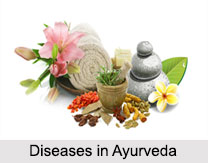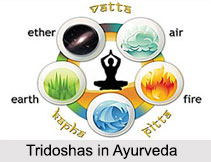 Diseases in Ayurveda are the state of body and mind in which a person experiences discomfort, pain and injury. The fundamental cause of disease is the imbalance of the Tridoshas – Vata, Pitta and Kapha. When the three doshas are balanced, the body experiences "Health" and the state of imbalance or disequilibrium is "Disease" or "Vyadhi" in Sanskrit. The imbalance may be due to an increase or decrease in one, two or all the three doshas. The individual is out of harmony both internally and with relation to the environment and experiences unpleasant sensations and misery in some form.
Diseases in Ayurveda are the state of body and mind in which a person experiences discomfort, pain and injury. The fundamental cause of disease is the imbalance of the Tridoshas – Vata, Pitta and Kapha. When the three doshas are balanced, the body experiences "Health" and the state of imbalance or disequilibrium is "Disease" or "Vyadhi" in Sanskrit. The imbalance may be due to an increase or decrease in one, two or all the three doshas. The individual is out of harmony both internally and with relation to the environment and experiences unpleasant sensations and misery in some form.
Ayurvedic Concept of Disease
The Ayurvedic concept of disease explains pathological condition in terms of doshas, dhatus and malas. The Ayurvedic concept of disease defines two terms, Vikruti and Prakruti. Vikruti is the abnormal or diseased condition of the body while Prakruti refers to the normal physiological and mental state.
Causative Factors of a Disease
According to Ashtanga Ayurveda, the causative factors of a disease are an imbalance in any or more of the Tridoshas, the seven dhatus, agni and the three malas. The imbalance may be caused by the following conditions: Asatmendriyarth Samyog, Aama, Pradnyaparadha and Parinama.
•"Asatmendriyarth Samyog" stands for improper or too much exploitation of the sense organs of vision, sound, smell, sense and touch.
•Aama is considered as the foremost cause of all disorders of human body. It develops from the undigested harmful materials, which block the various channels in the human body.
•"Parinama" refers to abrupt environmental changes, which makes the body vulnerable to disease.
•"Pradnyaparadha" is the improper use of intellect or wisdom that makes the body vulnerable to ailments.
Classification of Disease in Ayurveda
Diseases can affect both the physical structure (internal and external parts of the body) and the mind. Classification of Diseases in Ayurveda is done after taking many aspects into consideration, such as – similar characteristics, causative factors, numbers, Dosha involvement etc. The texts of Ayurveda suggest that diseases are also classified according to the underlying cause – whether it is psychological, physiological or an external factor. Such an intensive classification system facilitates proper treatment of diseases.




















